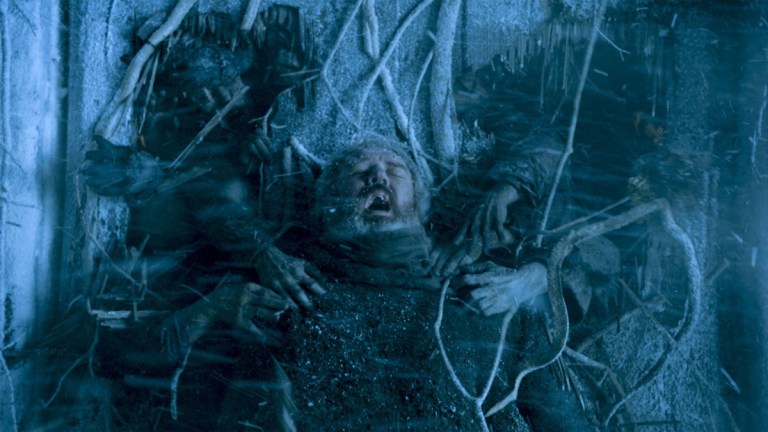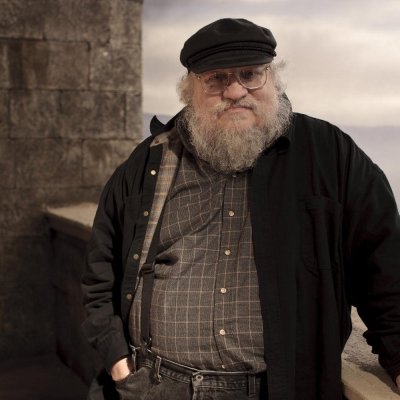Game of Thrones: George R. R. Martin on How Hodor’s Origin Story Was Changed for TV
In a new behind-the-scenes Game of Thrones book, Fire Cannot Kill a Dragon, GRRM explains how the book version of Hodor’s origin story differs slightly from the one we saw in season six

Contains spoilers for Game of Thrones season six
Game of Thrones didn’t lack for torture. Over eight seasons of whippings, beatings, nipple-ectomy, castration, dragonfire-immolation, head-melting and death-by-hot-rat (Season two, Harrenhal. Nasty.) the show overdelivered on its pain quota. One act of torture though, was more painful to see than all the others combined. Partly because it was inadvertent, partly because it was psychological, and partly because it happened to one of the few citizens of Westeros with a pure, good heart: Hodor.
That wasn’t his given name. Born Wylis, the servant to House Stark only became ‘Hodor’ after suffering a life-changing seizure in his youth. That event damaged his brain and took away his power of speech, leaving him only able to say the one word that would become his name.
If anybody needs a refresher, in season six, episode five ‘The Door’, Hodor’s ward Bran Stark was using his new-found mystical ability to observe past events when their group came under attack by the army of the dead. Paraplegic Bran had inserted himself into a moment from Hodor’s past when he was urged to return to the present and take control of (or ‘warg’ into) Hodor’s body to help fend off the attack.
In the confusion, Bran warged into young Wylis, accidentally forging a torturously painful psychic link between the stable boy and his adult self. When, in the present, Hodor was told to ‘Hold the door’ to allow Bran’s escape, Wylis heard the instruction in the past and a contraction of that phrase became the only word he was able to say. He’d psychically witnessed his own death as an adult and the trauma transformed him. Until he was torn apart by Wights, Hodor (played by Kristian Nairn) did hold the door, using his great heft to keep it closed and delay the army of the dead, sacrificing himself – just as Direwolf Summer had – until Bran could safely escape.
As reported in Vanity Fair, when the episode aired in May 2016, George R.R. Martin told the audience at a book event that in The Winds of Winter, the next instalment in GRRM’s A Song of Ice and Fire saga, Hodor’s origin story would play out differently.
Now, thanks to James Hibberd’s behind-the-scenes history of the HBO show Fire Cannot Kill a Dragon, we know what that slight difference is. In Chapter 23 of Hibberd’s book, Martin explains:
“I thought they executed it very well, but there are going to be differences in the book. They did it very physical – “hold the door” with Hodor’s strength. In the book, Hodor has stolen one of the old swords from the crypt. Bran has been warging into Hodor and practicing with his body, because Bran had been trained in swordplay. So telling Hodor to “hold the door” is more like “hold this pass” – defend it when enemies are coming – and Hodor is fighting and killing them. A little different, but same idea.”
In Hibberd’s expansive book, a detailed companion for any fan of the franchise, Martin also nominates Sibel Kekilli as Tyrion Lannister’s mistress Shae as the character whose screen incarnation was such an improvement on his book version that it made him wish he could go back in time and write her better.
Among countless other interesting details across the cast and creators, Martin also discusses a key difference between his version of character of Petyr Baelish, aka Littlefinger, and the character as he appears on screen, as played by Aiden Gillen. “My Littlefinger would never have turned Sansa over to Ramsay,” Martin tells Hibberd. “Never. He’s obsessed with her.”
Fire Cannot Kill a Dragon: Game of Thrones and the Official Untold Story of an Epic Series is published by Bantum Press on Tuesday the 6th of October

